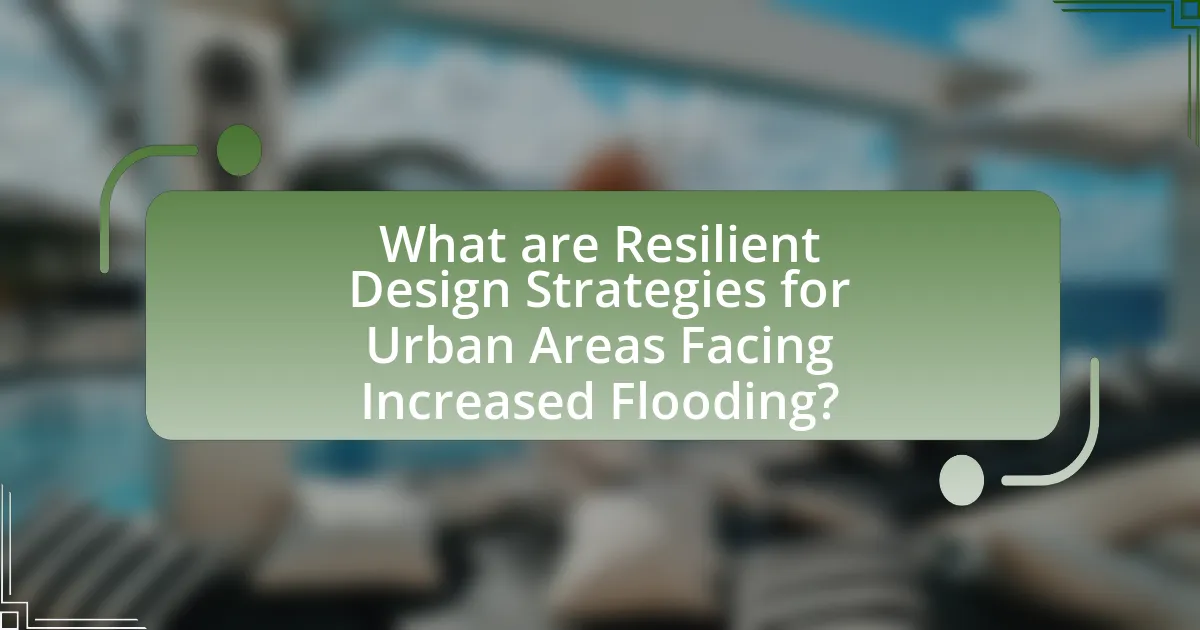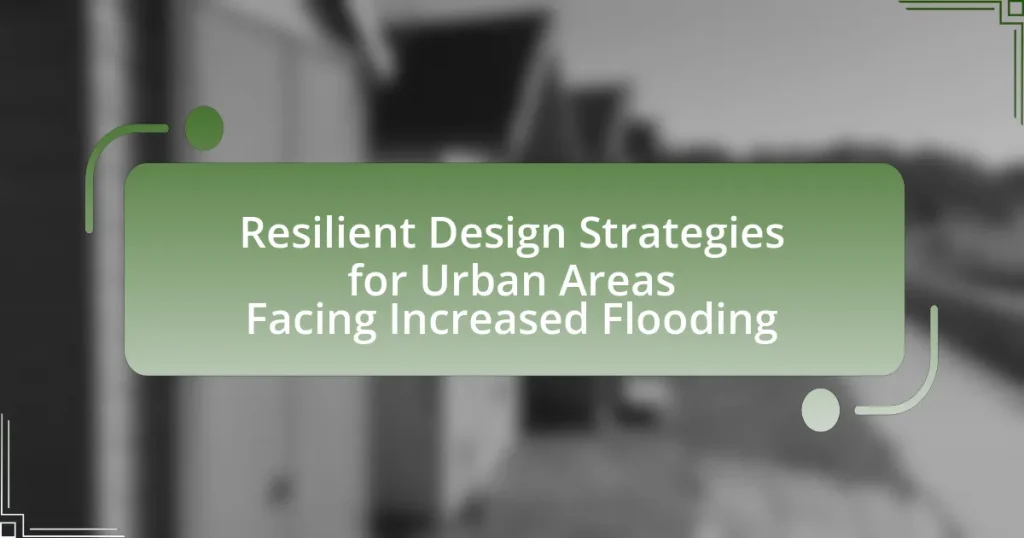Resilient design strategies for urban areas facing increased flooding focus on implementing green infrastructure, such as permeable pavements and green roofs, to enhance water absorption and reduce runoff. These strategies aim to address challenges like inadequate drainage systems and rising water levels due to climate change, promoting sustainable land use and community safety. The article discusses the differences between resilient design and traditional approaches, the importance of community engagement, and successful case studies from cities worldwide. It also highlights the key components necessary for effective implementation, including adaptability, sustainability, and robust infrastructure, while addressing potential barriers to acceptance and funding challenges.

What are Resilient Design Strategies for Urban Areas Facing Increased Flooding?
Resilient design strategies for urban areas facing increased flooding include the implementation of green infrastructure, such as permeable pavements and green roofs, which enhance water absorption and reduce runoff. These strategies are supported by studies indicating that green infrastructure can decrease urban flooding by up to 30% by allowing rainwater to infiltrate the ground rather than overwhelming drainage systems. Additionally, the construction of flood barriers and levees provides physical protection against rising water levels, while the integration of natural features like wetlands can absorb excess water and mitigate flood impacts. Urban planning that incorporates zoning regulations to limit development in flood-prone areas further strengthens resilience against flooding events.
How do these strategies address the challenges of urban flooding?
Resilient design strategies address the challenges of urban flooding by implementing measures that enhance drainage capacity, improve water retention, and promote sustainable land use. These strategies include the installation of permeable pavements, which allow water to infiltrate the ground, reducing surface runoff and minimizing flooding. Additionally, green roofs and rain gardens are utilized to absorb rainwater, thereby decreasing the volume of water that enters drainage systems. Evidence from cities like Copenhagen, which has integrated extensive green infrastructure, shows a significant reduction in flood events, demonstrating the effectiveness of these strategies in mitigating urban flooding risks.
What specific urban flooding challenges do these strategies target?
These strategies target specific urban flooding challenges such as inadequate drainage systems, increased surface runoff, and rising water levels due to climate change. Inadequate drainage systems often lead to water accumulation during heavy rainfall, causing localized flooding. Increased surface runoff, exacerbated by urbanization and impervious surfaces, contributes to the rapid influx of water into drainage systems, overwhelming them. Additionally, rising water levels from climate change threaten coastal urban areas, necessitating adaptive measures to protect infrastructure and communities.
How do resilient design strategies differ from traditional approaches?
Resilient design strategies prioritize adaptability and long-term sustainability in urban planning, contrasting with traditional approaches that often focus on short-term solutions and immediate functionality. Resilient design incorporates features such as green infrastructure, flood-resistant materials, and flexible land use, which enhance a community’s ability to withstand and recover from flooding events. In contrast, traditional approaches typically emphasize structural solutions like levees and drainage systems, which may not address the underlying vulnerabilities of urban areas. Research indicates that cities employing resilient design strategies can reduce flood-related damages by up to 50%, demonstrating their effectiveness in mitigating risks associated with climate change and urban flooding.
Why is it important to implement resilient design strategies in urban areas?
Implementing resilient design strategies in urban areas is crucial to mitigate the impacts of climate change, particularly increased flooding. These strategies enhance the ability of urban infrastructure to withstand extreme weather events, thereby reducing damage and ensuring public safety. For instance, cities like New Orleans have adopted resilient design principles post-Hurricane Katrina, leading to improved flood defenses and urban planning that incorporates green spaces to absorb excess water. Such measures not only protect property and lives but also promote sustainable development by integrating natural systems into urban environments, ultimately fostering long-term economic stability and community resilience.
What are the potential consequences of ignoring flooding risks?
Ignoring flooding risks can lead to severe consequences, including loss of life, significant property damage, and economic disruption. Historical data shows that areas unprepared for flooding can experience fatalities; for instance, Hurricane Katrina in 2005 resulted in over 1,800 deaths and billions in damages due to inadequate flood risk management. Additionally, ignoring these risks can strain emergency services and infrastructure, leading to long-term recovery challenges and increased insurance costs. Urban areas that fail to address flooding risks may also face decreased property values and hindered economic growth, as businesses are less likely to invest in high-risk locations.
How can resilient design strategies enhance community safety and sustainability?
Resilient design strategies enhance community safety and sustainability by integrating adaptive infrastructure that withstands environmental challenges, such as flooding. These strategies include the implementation of green roofs, permeable pavements, and flood-resistant buildings, which collectively reduce runoff and improve water management. For instance, cities like Rotterdam have adopted such designs, resulting in a 30% reduction in flood risk and improved urban biodiversity. By prioritizing resilience, communities not only safeguard lives and property but also promote long-term ecological health, demonstrating that effective design can lead to safer, more sustainable urban environments.
What principles guide the development of resilient design strategies?
Resilient design strategies are guided by principles such as adaptability, sustainability, and community engagement. Adaptability ensures that designs can respond to changing environmental conditions, such as increased flooding, by incorporating flexible infrastructure that can be modified over time. Sustainability focuses on minimizing environmental impact and promoting the use of renewable resources, which is essential in urban areas facing climate challenges. Community engagement involves involving local stakeholders in the design process to ensure that solutions meet the needs of the population and enhance social resilience. These principles are supported by case studies demonstrating successful implementations, such as the use of green infrastructure in cities like New York, which has shown to effectively manage stormwater and reduce flooding risks.
What role does community engagement play in these strategies?
Community engagement is crucial in resilient design strategies for urban areas facing increased flooding as it fosters collaboration between stakeholders, ensuring that the strategies are contextually relevant and widely supported. Engaging the community allows for the incorporation of local knowledge and preferences, which enhances the effectiveness of flood resilience measures. For instance, studies have shown that community-driven initiatives can lead to more sustainable outcomes, as seen in the case of the New York City Department of Environmental Protection’s community engagement efforts in the development of green infrastructure projects, which resulted in increased public support and participation.
How do environmental considerations influence resilient design?
Environmental considerations significantly influence resilient design by ensuring that structures and urban planning effectively respond to climate-related challenges, such as increased flooding. Resilient design incorporates natural systems, such as green infrastructure, which can absorb excess rainwater and reduce runoff, thereby mitigating flood risks. For instance, the implementation of permeable pavements and rain gardens has been shown to decrease surface water accumulation during heavy rainfall events, as evidenced by studies indicating that such measures can reduce urban flooding by up to 30%. Additionally, resilient design emphasizes the use of sustainable materials and energy-efficient systems, which not only lower environmental impact but also enhance the durability and adaptability of buildings in the face of changing climate conditions.
How can urban planners effectively integrate resilient design strategies?
Urban planners can effectively integrate resilient design strategies by adopting a multi-faceted approach that includes stakeholder engagement, data-driven decision-making, and the incorporation of green infrastructure. Engaging stakeholders ensures that community needs and local knowledge inform planning processes, which enhances the relevance and acceptance of resilient strategies. Data-driven decision-making involves utilizing climate models and risk assessments to identify vulnerable areas and prioritize interventions, such as flood-resistant buildings and improved drainage systems. The incorporation of green infrastructure, such as permeable pavements and green roofs, helps manage stormwater and reduce flooding impacts, as evidenced by studies showing that green roofs can reduce runoff by up to 75%. These strategies collectively enhance urban resilience against flooding and promote sustainable urban development.
What are the key components of successful resilient design strategies?
The key components of successful resilient design strategies include adaptability, sustainability, and community engagement. Adaptability ensures that designs can respond to changing environmental conditions, such as increased flooding, by incorporating flexible infrastructure that can be modified over time. Sustainability focuses on using eco-friendly materials and practices that minimize environmental impact while enhancing resilience against climate-related challenges. Community engagement involves involving local stakeholders in the design process, ensuring that the strategies meet the specific needs and preferences of the community, which fosters a sense of ownership and responsibility towards the resilience efforts. These components are essential for creating effective strategies that can withstand and recover from the impacts of flooding in urban areas.
What types of infrastructure are essential for resilience?
Essential types of infrastructure for resilience include green infrastructure, stormwater management systems, and robust transportation networks. Green infrastructure, such as parks and green roofs, helps absorb rainwater and reduce flooding. Stormwater management systems, including retention basins and permeable pavements, are designed to manage excess water during heavy rainfall, mitigating flood risks. Robust transportation networks ensure accessibility and mobility during emergencies, facilitating evacuation and response efforts. These infrastructures collectively enhance urban resilience against increased flooding, as evidenced by cities like New Orleans, which have implemented such strategies post-Hurricane Katrina to improve flood management and community safety.
How can green spaces contribute to urban resilience?
Green spaces contribute to urban resilience by enhancing stormwater management, reducing urban heat, and improving biodiversity. These areas absorb rainfall, which mitigates flooding by decreasing runoff and allowing water to infiltrate the ground. For instance, a study by the National Oceanic and Atmospheric Administration found that urban green spaces can reduce surface runoff by up to 50%, significantly lowering flood risks. Additionally, green spaces help lower temperatures in urban areas, which can be crucial during heatwaves, thereby improving public health and reducing energy consumption. Furthermore, they support diverse ecosystems, which can adapt to changing environmental conditions, thus strengthening the overall resilience of urban areas facing increased flooding.
What are some examples of successful resilient design strategies in urban areas?
Successful resilient design strategies in urban areas include the implementation of green infrastructure, such as permeable pavements and green roofs, which help manage stormwater and reduce flooding. For instance, New York City has integrated green roofs on public buildings, which not only absorb rainwater but also provide insulation and reduce urban heat. Additionally, the city of Rotterdam has developed water plazas that serve as recreational spaces during dry periods and as temporary water storage during heavy rainfall, effectively mitigating flood risks. These strategies demonstrate how urban areas can adapt to increased flooding through innovative design that enhances both resilience and livability.
How have cities around the world implemented these strategies?
Cities around the world have implemented resilient design strategies for urban areas facing increased flooding by integrating green infrastructure, enhancing drainage systems, and adopting zoning regulations. For instance, New York City has invested in green roofs and permeable pavements to absorb rainwater, while also upgrading its stormwater management systems to handle extreme weather events. In Rotterdam, the city has developed water plazas that serve as public spaces during dry periods and flood retention areas during heavy rainfall. Additionally, cities like Copenhagen have introduced climate adaptation plans that include elevating streets and buildings in flood-prone areas. These strategies are supported by research indicating that urban green spaces can significantly reduce surface runoff and improve water management.
What lessons can be learned from these case studies?
The lessons learned from case studies on resilient design strategies for urban areas facing increased flooding include the importance of integrating green infrastructure, enhancing community engagement, and implementing adaptive management practices. Green infrastructure, such as permeable pavements and green roofs, has been shown to effectively reduce runoff and improve water absorption, as evidenced by the success of projects in cities like Philadelphia, which reported a 10% reduction in stormwater runoff. Community engagement fosters local ownership and ensures that solutions meet the specific needs of residents, as demonstrated in New Orleans, where participatory design processes led to more effective flood mitigation strategies. Adaptive management practices allow for flexibility and responsiveness to changing conditions, which is critical in the face of climate variability, as highlighted by the ongoing adjustments made in Rotterdam’s flood defense systems.
What challenges do urban areas face when adopting resilient design strategies?
Urban areas face significant challenges when adopting resilient design strategies, primarily due to financial constraints, regulatory hurdles, and community engagement issues. Financially, many urban municipalities struggle with limited budgets, making it difficult to allocate sufficient resources for implementing comprehensive resilient design measures. Regulatory hurdles arise from existing zoning laws and building codes that may not support innovative design solutions aimed at enhancing resilience against flooding. Additionally, engaging the community in the planning process can be challenging, as differing priorities and a lack of awareness about the importance of resilient design can lead to resistance or apathy. These factors collectively hinder the effective adoption of strategies necessary to mitigate the impacts of increased flooding in urban environments.
How can funding and resource allocation impact implementation?
Funding and resource allocation significantly impact the implementation of resilient design strategies for urban areas facing increased flooding by determining the availability of necessary materials, technologies, and expertise. Adequate funding enables the development of infrastructure improvements, such as enhanced drainage systems and flood barriers, which are essential for effective flood management. For instance, a study by the National Oceanic and Atmospheric Administration (NOAA) found that cities investing in flood resilience measures can reduce long-term costs associated with flood damage by up to 50%. Additionally, proper resource allocation ensures that projects are prioritized based on vulnerability assessments, allowing for targeted interventions that maximize the effectiveness of the investments made.
What are the common barriers to community acceptance of these strategies?
Common barriers to community acceptance of resilient design strategies for urban areas facing increased flooding include lack of awareness, perceived costs, and distrust in authorities. Many community members are unaware of the benefits and necessity of these strategies, leading to resistance. Additionally, the perceived financial burden associated with implementing such strategies can deter acceptance, as residents may prioritize immediate economic concerns over long-term benefits. Distrust in government or organizations proposing these strategies can further complicate acceptance, as communities may question the motives or effectiveness of the proposed solutions. Studies have shown that effective communication and community engagement are essential to overcoming these barriers, highlighting the importance of transparency and education in fostering acceptance.
What best practices should urban planners follow when designing for resilience?
Urban planners should prioritize integrated water management, green infrastructure, and community engagement when designing for resilience. Integrated water management involves creating systems that effectively manage stormwater and reduce flooding risks, such as permeable surfaces and retention basins. Green infrastructure, including parks and green roofs, enhances urban ecosystems while absorbing excess rainwater, thereby mitigating flooding impacts. Community engagement ensures that local knowledge and needs are incorporated into planning processes, fostering a sense of ownership and enhancing the effectiveness of resilience strategies. These practices are supported by studies indicating that cities employing green infrastructure can reduce urban flooding by up to 30%, demonstrating their effectiveness in enhancing urban resilience.




